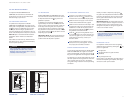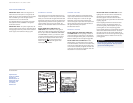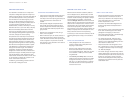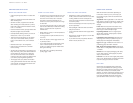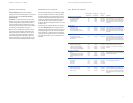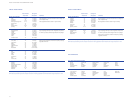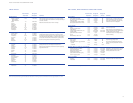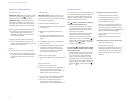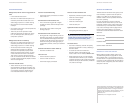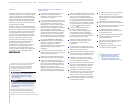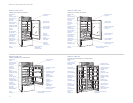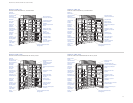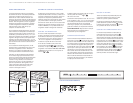
19
FRESH FRUITS
Recommended
Temperature
Storage Life
(refrigerator)
Comments
FRESH FRUITS
apples* (macintosh,
grimes golden,
yellow newtown)
a
pples
apricots
a
sian pears
a
vocados*
b
lackberries
b
lood oranges
blueberries
cantaloupe*
1–4˚C
-
1˚C
1˚C
1
˚C
4
˚C
1
˚C
4
–7˚C
1˚C
2–5˚C
1–2 months
3
–6 months
1–2 weeks
5
–6 months
2
–4 weeks
2
–3 days
3
–8 weeks
10–18 days
2–3 weeks
Wash and dry most fruits, and store in the crisper compart-
ment. (Do notwash berries and cherries until you are ready to
use them, however.)
Most fruits should be stored in lower humidity.
cassavas
cherries, sweet
clementines
cranberries*
f
igs, fresh
grapes
guavas*
honeydew
1˚C
1˚C
4˚C
2–4˚C
1
˚C
1˚C
4–7˚C
7˚C
1–2 months
2–3 weeks
2–4 weeks
2–4 months
7
–10 days
2–3 weeks
2–3 weeks
3–4 weeks
F
ully ripe fruits should bestored in the refrigerator atrecom-
mended temperatures to slow down the ripening process.
To hasten the ripening process, you can place unripe fruit in a
p
aper bag that has holespoked init. Close the bag andset it
on a counter. The fruit will produce ethylene, a gas thatiniti-
ates the ripening process.Check the bag each day.
k
iwifruit
kumquats
lychees
nectarines
oranges*
papayas*
peaches
pears
1
˚C
4˚C
2˚C
1˚C
1–7˚C
7˚C
1˚C
1˚C
4
–6 weeks
2–4 weeks
3–5 weeks
2–4 weeks
3–8 weeks
1–3 weeks
2–4 weeks
2–3 weeks
Discard any fresh fruits that are moldy or have other signs of
spoilage and wipe out the refrigerator compartment.
Refer to the list of ethylene sensitive and ethylene producing
vegetables andfruits.
persimmons
pineapple*
plums and prunes
pomegranates*
quinces
raspberries
rhubarb
strawberries
1˚C
7˚C
1˚C
4˚C
1˚C
1˚C
1˚C
1˚C
3–4 months
2–4 weeks
2–5 weeks
2–3 months
2–3 months
3–6 days
2–3 weeks
7–10 days
tangerines
watermelon*
4˚C
7˚C
2–4 weeks
2–3 weeks
*Sensitive tochill injury, a cause of spoilage. Damage may not beapparent untilthe fruit is returned toa warmer temperature.
NOTE: See foodpreservation guide forcomplete instructionson freezing fruits. Recommended freezer storage temperature is -18˚C.
DELI FOODS, DAIRY PRODUCTS AND OTHER FOODS
R
ecommended
T
emperature
S
torage Life
(
refrigerator)
S
torage Life
(
freezer)*
C
omments
DELI FOODS
thinly slicedlunch meats
egg, chicken,tuna and ham salads
macaroni salads
pre-stuffed chops, chicken breasts
store-prepared conveniencemeals
1–2˚C
1–2˚C
1–2˚C
1–2˚C
1–2˚C
1–2 days
3–5 days
3–5 days
1 day
1–2 days
NR
NR
NR
NR
NR
Check ”use by” or ”sell by” dates. These
foods do not freeze well. If you need to
freeze, do soimmediately, not after they
have been heldin the refrigerator.
D
AIRY FOODS
b
utter
cottage or ricotta cheese
cream cheese
natural cheese (cheddar, brick, etc.)
process cheese
grated Parmesan or Romano
yogurt
w
hole, lowfat or skim milk
1
–2˚C
1–2˚C
1–2˚C
1–2˚C
1–2˚C
1–2˚C
1–2˚C
1
–2˚C
3
months
1–2 weeks
2 weeks
3–6 months
3–4 weeks
1 year
1 month
1
–2 weeks
1
year
4 weeks
6–8 months
6–8 months
C
heck ”sell by” dates.
Store cheese in original packaging until
ready to use.After opening, rewraptightly
in plastic wrap or aluminum foil.
Thaw frozen cheese in the refrigerator to
reduce crumbling.
EGGS
fresh, in shell
h
ard cooked
liquid pasteurized or egg substitutes
o
pened
unopened
1˚C
1
–2˚C
1
–2˚C
1–2˚C
3 weeks
1
week
3
days
10 days
NR
N
R
N
R
1 year
Keep fresh eggs refrigerated.
D
o not eat hardcooked eggs that have
been at room temperature for more than
2
hours.
COOKED MEAT & POULTRY LEFTOVERS
cooked meat and meat dishes
gravy and meat broth
fried or plain chicken, pieces
cooked poultry dishes
pieces covered with broth,gravy
chicken nuggets, patties
1–2˚C
1–2˚C
1–2˚C
1–2˚C
1–2˚C
1–2˚C
3–4 days
1–2 days
3–4 days
3–4 days
1–2 days
1–2 days
2–3 months
2–3 months
4 months
4–6 months
6 months
1–3 months
Refrigerate or freeze leftoversin covered
shallow containers within 2hours after
cooking. Reheat leftovers to 74˚C.
SOUPS & STEWS
vegetable
meat added
1–2˚C
1–2˚C
3–4 days
3–4 days
2–3 months
2–3 months
Reheat to at least 74˚Cbefore serving.
*Recommended freezer storage temperature is -18˚C. (NR) stands for not recommended forfreezing.
FOOD STORAGE RECOMMENDATIONS



